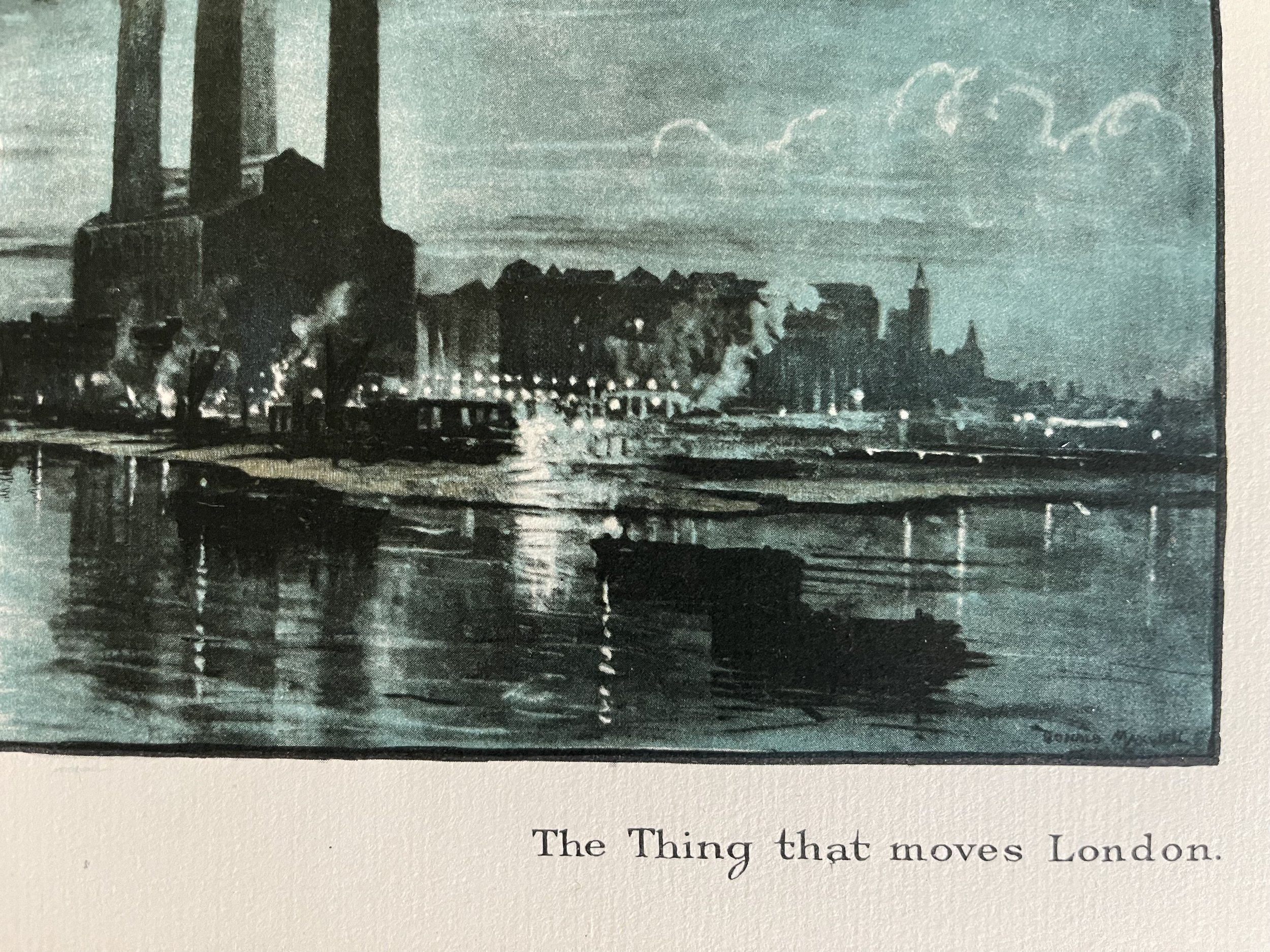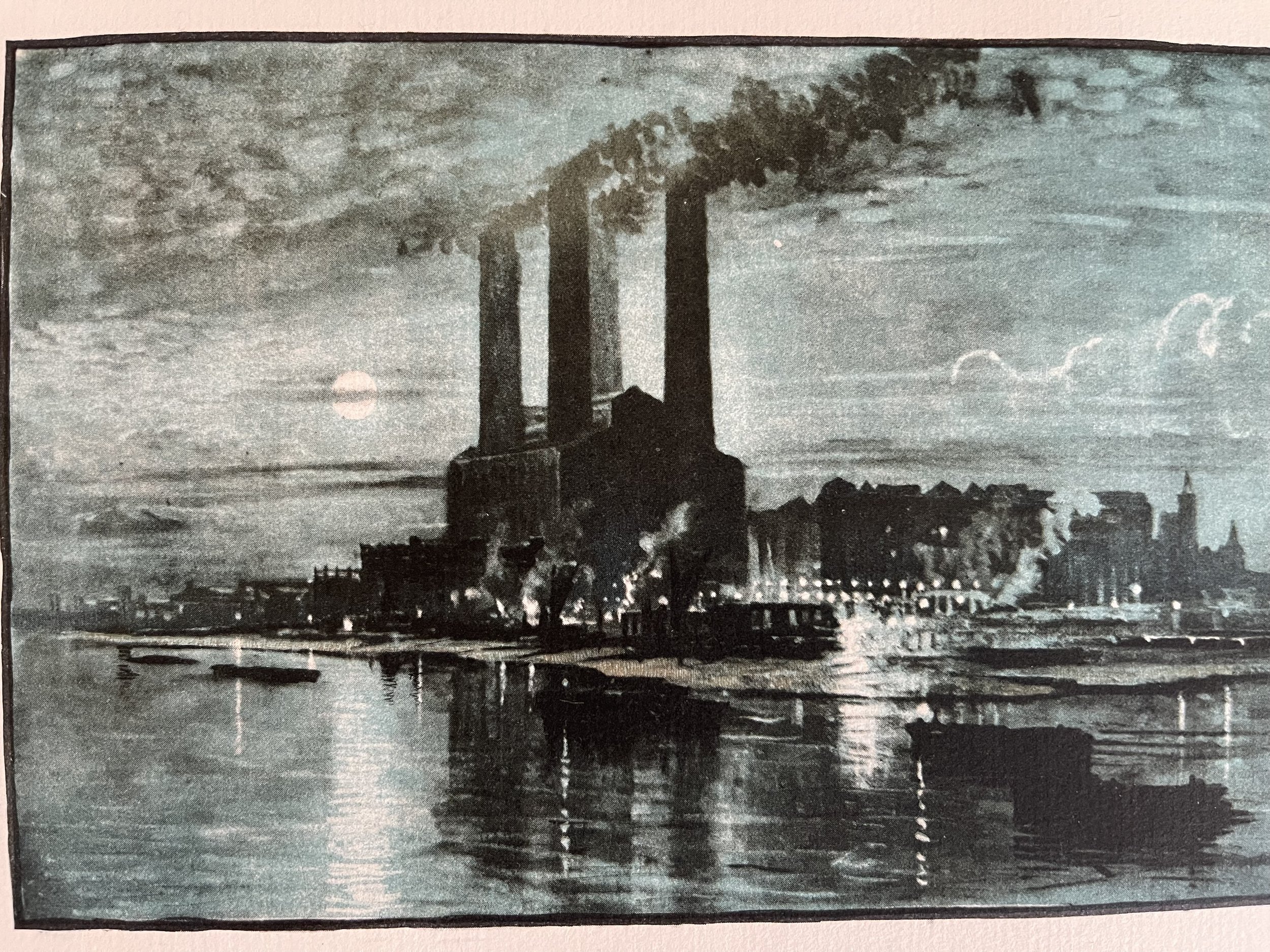Lots Road Power Station - Herbert Jenkins - 1926
The thing that moves London. Lots Road Power Station. Illustration for The New Lights O'London (Herbert Jenkins, 1926). Colour Lithograph.
In 1912 Jenkins founded his own publishing company: Herbert Jenkins Limited. Its offices were in a narrow, 19th-century building with five floors in Duke of York Street, just off Jermyn Street in London. It was a successful business from the start because of Jenkins' unique ability (at the time) to cater for the ever-changing public taste. He also had a good eye for new talent, not being discouraged if a manuscript had been rejected by other publishers.
His publicity methods were innovative, too; with arresting advertisements and dust jackets, and a monthly publication called Wireless, which was widely circulated among his readers. Jenkins' first publication was Willie Riley's first novel Windyridge, and the firm went on to publish most of Riley's 39 books, ending with The Man and the Mountain in 1961, the year of Riley's death. In 1915 Jenkins published A. S. Neill's first book, A Dominie's Log, launching his career as a famous teacher and writer of books on education. Herbert Jenkins Ltd published many of P. G. Wodehouse's novels, starting with Piccadilly Jim in 1918.
By the 1950s – long after Jenkins' death – the company was still being run as a 1930s business might have been. In 1964 it merged with Barrie & Rockcliffe to form Barrie & Jenkins, which continued to publish Wodehouse's novels, but specialised in books about ceramics, pottery and antiques. In 1969 the company published the first of George MacDonald Fraser's popular The Flashman Papers novels after it had been rejected by many other publishers. Barrie & Jenkins had a short commercial history and was taken over by Hutchinson, who were themselves taken over by Century and then by Random House (now owned by Bertelsmann). It continues to exist as a specialist imprint mainly for hardback editions within the Random House stable.
The thing that moves London. Lots Road Power Station. Illustration for The New Lights O'London (Herbert Jenkins, 1926). Colour Lithograph.
In 1912 Jenkins founded his own publishing company: Herbert Jenkins Limited. Its offices were in a narrow, 19th-century building with five floors in Duke of York Street, just off Jermyn Street in London. It was a successful business from the start because of Jenkins' unique ability (at the time) to cater for the ever-changing public taste. He also had a good eye for new talent, not being discouraged if a manuscript had been rejected by other publishers.
His publicity methods were innovative, too; with arresting advertisements and dust jackets, and a monthly publication called Wireless, which was widely circulated among his readers. Jenkins' first publication was Willie Riley's first novel Windyridge, and the firm went on to publish most of Riley's 39 books, ending with The Man and the Mountain in 1961, the year of Riley's death. In 1915 Jenkins published A. S. Neill's first book, A Dominie's Log, launching his career as a famous teacher and writer of books on education. Herbert Jenkins Ltd published many of P. G. Wodehouse's novels, starting with Piccadilly Jim in 1918.
By the 1950s – long after Jenkins' death – the company was still being run as a 1930s business might have been. In 1964 it merged with Barrie & Rockcliffe to form Barrie & Jenkins, which continued to publish Wodehouse's novels, but specialised in books about ceramics, pottery and antiques. In 1969 the company published the first of George MacDonald Fraser's popular The Flashman Papers novels after it had been rejected by many other publishers. Barrie & Jenkins had a short commercial history and was taken over by Hutchinson, who were themselves taken over by Century and then by Random House (now owned by Bertelsmann). It continues to exist as a specialist imprint mainly for hardback editions within the Random House stable.
The thing that moves London. Lots Road Power Station. Illustration for The New Lights O'London (Herbert Jenkins, 1926). Colour Lithograph.
In 1912 Jenkins founded his own publishing company: Herbert Jenkins Limited. Its offices were in a narrow, 19th-century building with five floors in Duke of York Street, just off Jermyn Street in London. It was a successful business from the start because of Jenkins' unique ability (at the time) to cater for the ever-changing public taste. He also had a good eye for new talent, not being discouraged if a manuscript had been rejected by other publishers.
His publicity methods were innovative, too; with arresting advertisements and dust jackets, and a monthly publication called Wireless, which was widely circulated among his readers. Jenkins' first publication was Willie Riley's first novel Windyridge, and the firm went on to publish most of Riley's 39 books, ending with The Man and the Mountain in 1961, the year of Riley's death. In 1915 Jenkins published A. S. Neill's first book, A Dominie's Log, launching his career as a famous teacher and writer of books on education. Herbert Jenkins Ltd published many of P. G. Wodehouse's novels, starting with Piccadilly Jim in 1918.
By the 1950s – long after Jenkins' death – the company was still being run as a 1930s business might have been. In 1964 it merged with Barrie & Rockcliffe to form Barrie & Jenkins, which continued to publish Wodehouse's novels, but specialised in books about ceramics, pottery and antiques. In 1969 the company published the first of George MacDonald Fraser's popular The Flashman Papers novels after it had been rejected by many other publishers. Barrie & Jenkins had a short commercial history and was taken over by Hutchinson, who were themselves taken over by Century and then by Random House (now owned by Bertelsmann). It continues to exist as a specialist imprint mainly for hardback editions within the Random House stable.
Code : A410
Cartographer : Cartographer / Engraver / Publisher: Herbert Jenkins
Date : Publication Place / Date - London 1926
Size : Sheet size: Image Size: 24 x 16 cm
Availability : Available
Type - Genuine Vintage / Antique - 98 years old
Grading - A
Tracked postage, in casement. Please contact me for postal quotation outside of the UK.




